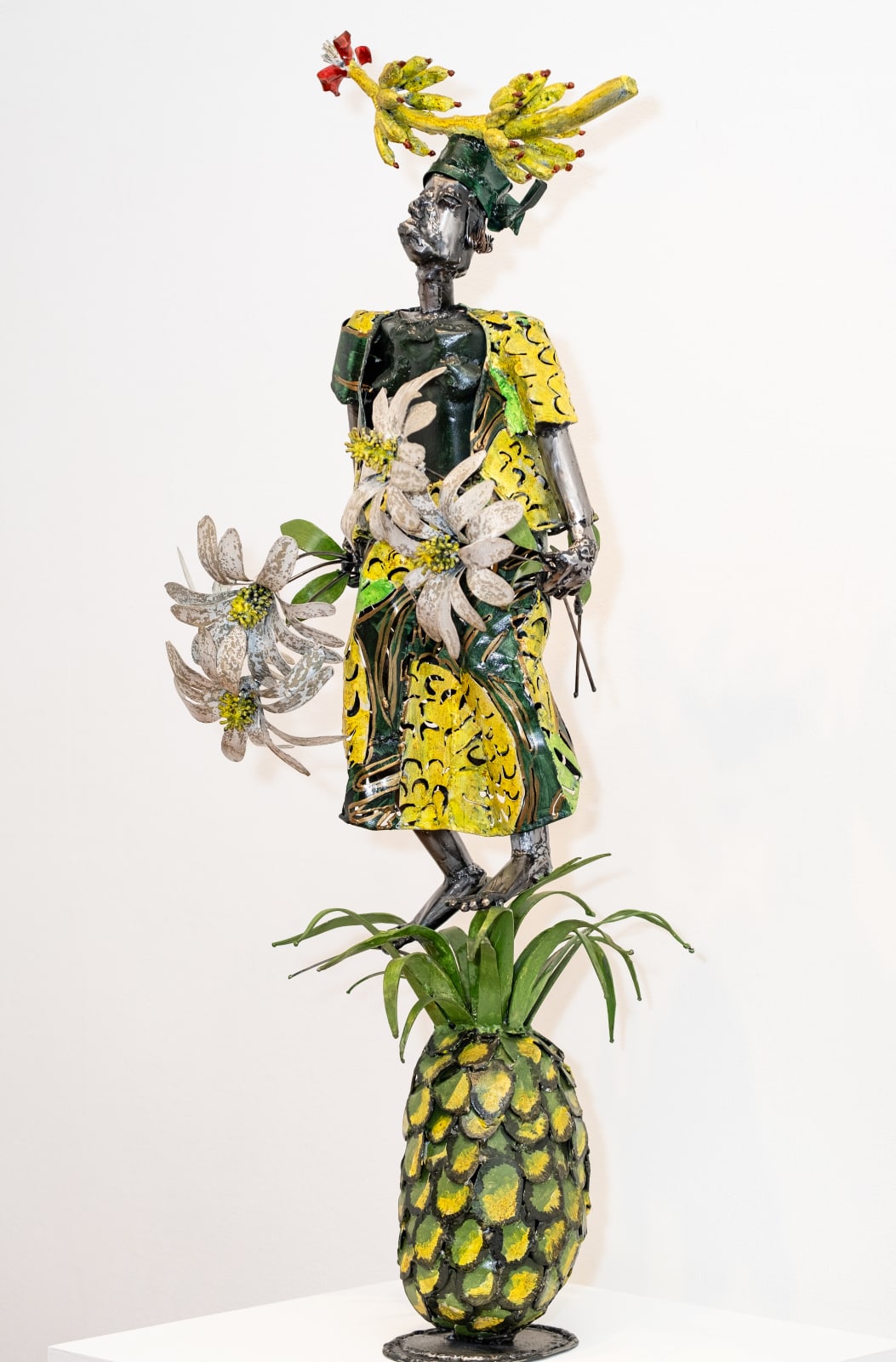
Sokari Douglas Camp
Pineapple Daisy, 2024
Mild steel acrylic paint
107 x 43 x 34 cm
© Sokari Douglas Camp.
Pineapple Daisy - in steel and coloured acrylic paints – is a flamboyant sculpture showing both the joyful approach to life and the resolutely independent attitude typically found amongst women...
Pineapple Daisy - in steel and coloured acrylic paints – is a flamboyant sculpture showing both the joyful approach to life and the resolutely independent attitude typically found amongst women of the tropics. This standing sculpture is part of the Sibylla Pineapple series, which pays homage to Maria Sibylla Merian, a 17th century German natural scientist, artist and explorer. A specialist in the life cycles of butterflies and moths, Merian studied the close relationships existing between insects and particular plants, travelling widely to further her research. In 1699, Merian sailed to Suriname – then, a Dutch colony bordering Brazil to the south - where for two years she collected plant and animal specimens, may of which were unknown to western science. These results eventually appeared in her ground-breaking magnum opus, Metamorphosis of the Insects of Suriname (1705). Merian, like other western explorers (Banks, Solander, von Humboldt, etc.), relied heavily on the local knowledge of indigenous and enslaved peoples to document the wealth of exotic flora and fauna, while also recording in her notes the inhumane conditions under which they laboured in the Dutch sugar cane plantations.
Douglas Camp notes that colonial rule is a two-sided coin, and that the experiences of the coloniser and the colonised, even when based upon the same reality, can b e entirely distinct. She writes, “As a woman, I notice how colonised peoples and women of the Diaspora cope; how they fashion their own styles, using whatever materials are to hand; how they forge a self-image that, by imitating and distorting their opporessors’ image of them, creates something uniquely their own.” Working spontaneously and without preconceived notions, each figure in the series records the elaborate interplay between the artist’s fleeting intuitions and the stolid and unbending nature of steel. The woman in Pineapple Daisy stands barefoot atop a pineapple pedastel, holding flowers of peace in each hand. In carrying even more fruit on her head, she symbolises abundance and the generosity of nature. She is dressed in pineapple patterned materials in the kotomisi style particular to Surinamese women, who wear ruffles below the waist of their skirts. These ruffles came from Surinamese women’s habit of wearing many skirts at once, being unable to store them safely. For the creole women of colonial times these layers of ‘petticoats’ not only disguised their figures, they also served as protection against being molested. Ruffled skirts are worn by young women, today, as articles of high fashion.
The Sibylla Pineapple series considers the cultural histories of ‘exotic’ fruits, looking at the manner in which they were ‘discovered,’’produced’ and ‘enjoyed.’ Native to South America, the pineapple was cultivated by the Aztec and Maya peoples in ancient times. When ‘discovered’ by Columbus, it was taken to Spain as a rare and exotic trophy from a newly conquered, far-off world, where it quickly became a symbol of status and wealth. It required great expense to create heated frames and glass-houses where this tropical plant could be grown and propagated. Single pineapples could then be rented out to noble houses where, displayed on pedastels for all to admire, they would be exhibited at banquets and feasts to signify western notions of wealth, welcome and generosity. Eventually, plantations were established throughout the global south, often using indentured and/or migrant workers, where pineapples and bananas were grown to service the burgeoning global market.
Douglas Camp notes that colonial rule is a two-sided coin, and that the experiences of the coloniser and the colonised, even when based upon the same reality, can b e entirely distinct. She writes, “As a woman, I notice how colonised peoples and women of the Diaspora cope; how they fashion their own styles, using whatever materials are to hand; how they forge a self-image that, by imitating and distorting their opporessors’ image of them, creates something uniquely their own.” Working spontaneously and without preconceived notions, each figure in the series records the elaborate interplay between the artist’s fleeting intuitions and the stolid and unbending nature of steel. The woman in Pineapple Daisy stands barefoot atop a pineapple pedastel, holding flowers of peace in each hand. In carrying even more fruit on her head, she symbolises abundance and the generosity of nature. She is dressed in pineapple patterned materials in the kotomisi style particular to Surinamese women, who wear ruffles below the waist of their skirts. These ruffles came from Surinamese women’s habit of wearing many skirts at once, being unable to store them safely. For the creole women of colonial times these layers of ‘petticoats’ not only disguised their figures, they also served as protection against being molested. Ruffled skirts are worn by young women, today, as articles of high fashion.
The Sibylla Pineapple series considers the cultural histories of ‘exotic’ fruits, looking at the manner in which they were ‘discovered,’’produced’ and ‘enjoyed.’ Native to South America, the pineapple was cultivated by the Aztec and Maya peoples in ancient times. When ‘discovered’ by Columbus, it was taken to Spain as a rare and exotic trophy from a newly conquered, far-off world, where it quickly became a symbol of status and wealth. It required great expense to create heated frames and glass-houses where this tropical plant could be grown and propagated. Single pineapples could then be rented out to noble houses where, displayed on pedastels for all to admire, they would be exhibited at banquets and feasts to signify western notions of wealth, welcome and generosity. Eventually, plantations were established throughout the global south, often using indentured and/or migrant workers, where pineapples and bananas were grown to service the burgeoning global market.